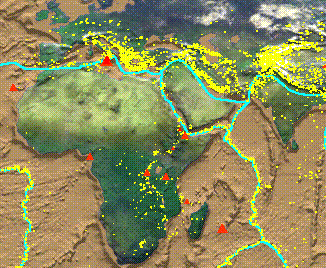NUR
IS NOT the first to suggest earthquakes were a major player in the
region's history, but he's given the idea new life. In the late 1940's,
archaeologist Claude Schaeffer published a paper and later a book
blaming earthquakes for the great Middle Eastern cities' fall at the
end of the Bronze Age. Schaeffer's work met with great resistance
from the archaeology community. "Schaeffer was famous before the book,
and infamous after," Nur says. He is not merely picking up Schaeffer's
theory-he's backing it up with hard scientific evidence. But while
scholars are slowly warming to the quake theory, Nur's recent attempts
at popularizing it still haven't gained wide acceptance.
|

The
quake zone seen from space. Image courtesy NASA
|
One reason is that archeologists resent "an outsider
coming in and thinking he can do better something we've been training
our whole lives to do," Xavier archaeologist Cline says. And Nur's
approach has made matters worse. "Nur's tone has been that of an enthusiastic
bystander," says Cline. "At first, Nur said quakes ended the Bronze
Age, that's not the case. But earthquakes may have contributed to
the end of the Bronze Age," Cline says. Bold proclamations like that
make archaeologists wary. "There are forbidden topics in archaeology
and if you really want to be considered a serious scholar, you must
avoid them," Cline says. Nur's early work on the theory invoked Bible
passages and myths of Armageddon, which Cline believes reduced his
credibility with serious scholars.
Nur contends scholars resist the notion earthquakes
ended the Bronze Age is that, "Historians don't want to accept that
random events changed history." As evidence, he cites a 1991 paper
by Elizabeth French, former director of the British School of Archaeology
and a leading excavator at Mycenae, "Archaeologists of my generation
who attended university in the immediate aftermath of Schaeffer's
great work in 1948, were brought up to view earthquakes, like religion,
as an explanation of archaeological phenomena to be avoided if at
all possible."
But Vanderbilt historian Drews disagrees that historians
resent random events, "I think we have to accept it (a random event)
when it's fact. What historians would object to is the random resort
to either supernatural or very unusual or unprecedented events of
this kind (to explain history). I don't know of any place in antiquity
where an earthquake ever destroyed a city," Drews says, "but we know
of thousands of places destroyed by human beings." He says scientists
are overly anxious to apply their trades to history. "Scientists may
prefer to think that some of these interesting events have natural
causes rather than human ones, so they're eager to find natural disasters
to explain them.
Drews insists the evidence doesn't support Nur's
theory. "If the place was suddenly destroyed, you'd expect to find
all the things in the palace buried in debris, and we don't," he says.
While archaeological digs have yielded some pottery, there are no
beautiful treasures like ivory or gold, Drews says. Drews cites the
small numbers of casualties as further proof against the earthquake
theory. "We'd expect quakes to trap people suddenly, but we don't
see evidence of that," he says. Though archaeologists have found some
crushed skeletons, Drews believes an earthquake-destroyed city would
have widespread casualties. But Nur offers a simple explanation, "When
we have an earthquake nowadays, we dig through the rubble, find the
victims and bury them." He says there's no reason to believe things
were different then.
Cline says the problem's crux is that it's difficult
to differentiate between earthquake damage and human inflicted destruction.
Both warfare and earthquakes can topple walls, start fires, and leave
skeletons in the rubble. Even at sites where earthquakes are clearly
implicated, there's no easy way to tell if the quake happened a hundred
or a thousand years ago. "You can't deny there were earthquakes, that's
a given, but the question is, what role did they play?" Cline says.
"What I adhere to is the 'systems collapse' (model): the civilization
as we know it comes to an end, but it's not from one cause, but from
a series of events and factors. It was almost a domino effect, one
domino may have been earthquakes."
<<
previous page || next page >>
|


